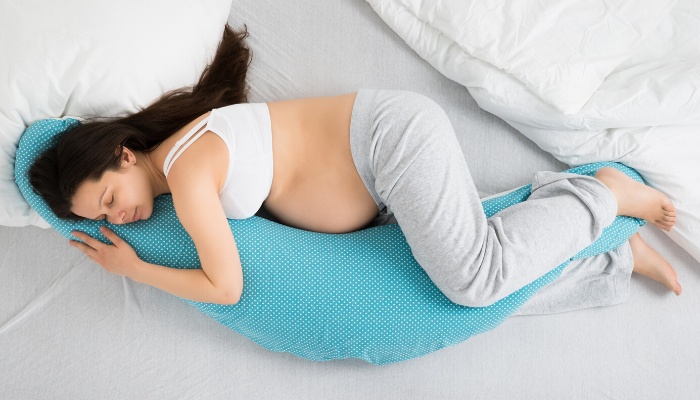Although there is not a single definitive sleeping position that guarantees the onset of labor, there are several positions that can promote it by utilizing gravity to widen the pelvis, apply pressure on the cervix, and stretch the perineum.
The 4 most popular positions include:
- Side-lying
- Sitting upright
- Slightly reclined
- Kneeling
According to Lamaze International:
“If your goal is to ‘get things moving along’ in labor, there are specific positions you can use that are known to do just that.
Gravity and movement play key roles in the progression of birth, however, and it’s important to use both of these to your advantage when possible.”
Table of Contents
1. Side-Lying With Upper Leg Forward, Bent and Elevated
This side-sleeping position, known as the Sim’s Position, helps to relax the hips, gently stretch the perineum, widen your pelvis, and encourage the baby into a good position for delivery.
When I had to be induced with my twins, this was the best position that helped me dilate very quickly.
In this position, you lie on your side, almost on your belly.
Pull your top leg up and forward to make a 90-degree angle. Place it on a stack of pillows to elevate it.
You can use a couple of pregnancy support pillows to help you with this one.
A long full-body pillow can help keep your leg elevated at night, and an optional pillow wedge can support your bump for extra comfort.
TIP: You can do this on your left OR right side. A 2019 medical review found that either position is safe for women in the third trimester. Only a supine sleeping position (on your back) has been associated with health risks for mother and baby.
2. Sitting Upright
Gravity is your friend at this late stage, so sleeping in an upright sitting position means the baby is pressing on your cervix and encouraging it to open.
It may also help your little one get into the optimal birthing position (head down and facing your spine).
Use a back support pillow to cushion your back from the headboard or couch, and keep your legs either closed, apart, or in a crossed position.
Try each position to see what feels most comfortable for you.
3. Slightly Reclined
A C-shaped or L-shaped pregnancy pillow can help you sleep comfortably in a semi-reclined position.
This position is quite common to give birth in as the pelvis is open and fully accessible while the legs are in a wide symmetrical pose.
Note that this may not feel comfortable if you’re experiencing tailbone pain or pain from “back labor” (when the baby is facing your belly, causing your ligaments to stretch due to the added weight of their front-facing position).
4. Kneeling
Another beneficial sleeping position — and one commonly adopted during labor — is kneeling. This helps to open up your pelvis and ease back pain.
This can be much simpler if you have an adjustable bed that raises up in a reclined position, allowing you to kneel on the lower portion of the bed while resting your upper body and arms on the raised head of the bed.
If not, you can still replicate this by kneeling on a pile of support pillows facing your headboard.
You can also try resting in this position during the day using a birthing/exercise ball if you have one.
| Sleeping Position | Benefits |
|---|---|
| Side-lying | Gently stretches perineum, widens pelvis |
| Sitting upright | Puts pressure on cervix, encouraging it to open |
| Slightly reclined | Puts pressure on cervix, encouraging it to open |
| Kneeling | Helps to open pelvis |

Safety of Trying To Induce Labor at Home
It is not recommended to try to induce labor before 39 weeks, especially if you are at home without medical supervision.
The safest labor is one that happens on its own.
However, if you have passed 40 weeks gestation and want to try to encourage the onset of labor, it’s critical to prioritize safety and consider the potential risks associated with various methods.
Here are some safety considerations:
Avoid Unproven Methods
Some methods, such as herbal supplements, certain foods, or alternative therapies, are often suggested for inducing labor but may lack scientific evidence supporting their effectiveness and safety.
Be cautious about unproven methods, and seek advice from medical professionals.
Risks of Premature Labor
Inducing labor too early can lead to complications associated with premature birth, including respiratory and developmental issues for the baby.
It’s crucial to wait until you are full-term (at least 39 weeks gestation) unless there are medical reasons for inducing labor earlier.
Use Natural Methods With Caution
Natural methods, such as nipple stimulation, walking, or certain exercises, are sometimes suggested to encourage labor.
While these activities are generally safe, approach them with caution and do not overexert yourself, especially if you have any underlying health concerns.
Avoid Certain Substances
Some substances, like castor oil, have been suggested as methods to induce labor.
However, these can have side effects such as diarrhea and dehydration and may not be safe for everyone.
Discuss the use of any substances with your healthcare provider before trying them.
Exercises and Stretches To Induce Labor
These exercises and stretches are said to help engage your baby into your pelvis and encourage dilation.
- Walking: Walking is thought to encourage labor by promoting the baby’s descent into the pelvis, engaging the pelvic floor muscles, and potentially stimulating contractions through hormonal release.
- Curb Walking: To take your walking game up a notch, you could try “curb walking.” This uneven gait is said to help nudge your body into labor by opening your pelvis and encouraging the baby to get into a deeper position.
- Squats: Doing a few squat reps a few times a day can help coax the baby into an ideal birthing position by putting pressure on the pelvis and pushing the baby toward the birth canal.
- Labor Lunge: Different than a normal forward lunge, a labor lunge is done with the front leg out to the side and often propped up on a low stool. This helps to move the baby down.
- Butterfly Stretch: The butterfly stretch is a seated stretch that involves opening the hips and bringing the soles of the feet together. At the end of your third trimester, this stretch can help engage the baby into the pelvis and potentially induce labor.
- Pelvic Tilts: These movements can encourage the baby to move into a favorable position for birth or stimulate the uterus.
- Gently Bouncing on Exercise Ball: Sitting or gently bouncing on an exercise ball in a wide-leg position not only keeps you in an upright posture to let gravity do its thing, but it also helps to open up the pelvis, increase blood flow, and encourage the cervix to dilate.
- Get on All Fours: Assuming the hands-and-knees position can help with optimal fetal positioning, increase pelvic diameter (providing more space for the baby to descend), and encourage the baby to rotate into an optimal position for delivery.
- Swaying Hips: There is a belief that “slow dancing” or swaying the hips can help promote labor because the gentle movements may encourage the baby to move down into the pelvis and stimulate contractions.
Other Natural Ways To Induce Labor
As for other natural ways of encouraging labor, always be sure to get your doctor’s approval before taking any supplements or using stimulating methods.
You want to make sure your labor is given a healthy “nudge” rather than a full-on shove!
- Sex: When you orgasm, the oxytocin released in your body can cause uterine contractions. Also, semen contains prostaglandins, a hormone that can essentially help to soften and ripen your cervix.
- Nipple Stimulation: This releases oxytocin into the body, which in turn can cause your uterine muscles to contract. *This trick can sometimes work too well, causing strong and prolonged contractions, which may decrease blood flow to your little one. Speak with your doctor about safe levels of nipple massage.
- Acupuncture and Acupressure: These are thought to help kickstart uterine contractions and activity, signaling showtime for your baby!
- Evening Primrose Oil: A few studies have found that primrose oil helps the cervix to ripen faster.
- Red Raspberry Leaf Tea: It’s often claimed that sipping on raspberry leaf tea can help strengthen the uterus and assist in uterine contractions during labor.
- Massage: A nice, soothing massage brings on the happy hormone oxytocin and gives you that warm, loosey-goosey feeling that can be quite conducive to labor.
- Castor Oil: This is thought to help encourage the uterine muscles to contract, but it should be used with caution and under your doctor’s guidance.
- Getting Cozy in Bed: Relaxation triggers the release of oxytocin in the body and promotes contractions.
Mom of three (including identical twin boys), wife, and owner of Parents Wonder. This is my place to share my journey as a mother and the helpful insights I learn along the way.

